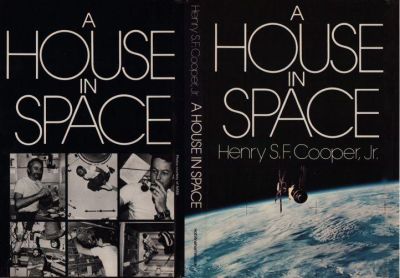And Learn How to Fly
A House in Space
By Henry S. F. Cooper

17 Mar, 2019
Henry S. F. Cooper, Jr’s 1976 A House in Space is a short account of Skylab, America’s first manned space station.
Skylab was launched in 1973 by the final Saturn Five to go into space; it was the last achievement of the Apollo program. The space station spent six years orbiting the Earth before re-entering, but was only occupied for 172 days (well, 171 days, 13 hours), by three crews. A fourth mission, planned to last 20 days, was cancelled.
During the 172 days of the combined missions, the crews — SL2 (Pete Conrad, Joseph Kerwin, and Paul Weitz), SL3 (Alan Bean, Owen Garriott, and Jack Lousma) and SL4 (Gerald Carr, Edward Gibson, and William Pogue) — carried out a highly scheduled series of experiments, not least of which was a study of the long term effects of free-fall on humans. The experiment cost some 20M dollars per man-day, which meant that there was pressure to produce results worth the investment1.
Was it all worth it? Well, that depends on how you feel about the sort of basic, even primitive, research that might some day lead to more ambitious projects. Skylab, despite all the design flaws and mishaps, provided the US with useful information on long-term (by the standards of the day) residence in space. As well, it provided some unexpected information about the behavior of the upper atmosphere when its premature re-entry was monitored.
As for this book: the suck fairy has visited this old favourite in the forty years since I last read it. It’s a mess. It’s poorly organized and way too brief, which means that it can give only a lamentably shallow treatment of this pioneer venture. I was particularly struck by the cursory treatment of the astronauts who made this venture work. They are less real people than cardboard cut-outs tagged with a few adjectives. We don’t learn anything about the third crew other than their complaints (which some took as mutiny) in the face of an unreasonable workload.
My mature judgment is that this book was written quickly and published without much in the way of editorial input.
For all its flaws, it still had an influence on the SF of the time. I remember a glowing review of the book by Spider Robinson (actually, according to ISFDB, in fact he reviewed it twice, once for Analog and once for Destinies). This was one of the first books on what living in space might actually be like, which is handy if you are writing a book about living in space. I am fairly sure this text influenced Gordon R. Dickson’s The Far Call and very sure it played a role in the creation of Robinson and Robinson’s Stardance.
Although Skylab was not the first space station (that would have been Salyut 1, in 1971) it did mark humanity’s first sustained habitation of space. Ever since its launch, there has always been least one space station in orbit around the Earth.
Skylab deserves a definitive text. Unfortunately, A House in Space is not that text.
A House in Space is out of print.
1: Note the Doonesbury comic about the cost-per-hour of Skylab astronaut time.
